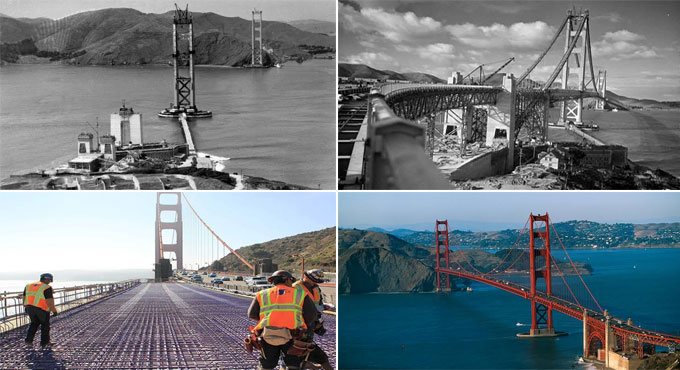
Golden Gate Bridge - A Feat of Construction Engineering
Possibly the most famous bridge in the United States of America, the Golden Gate Bridge spans a mile across the Golden Gate strait. The historically famous bridge connects San Fransisco city to Main county and carries two highways with it - Route 1 and Route 101. One of the reasons this picturesque bridge is so famous because at the time of construction it was the longest suspension bridge in the world. Its construction began in January 1933 and it was open for public use in April 1937. It is 8981 feet long in total or 2.7 kilometres. At that time, this was a marvellous feat of construction engineering.
Today we will look at how this feat was achieved.
Geographical Challenges: The Golden Gate strait, across which flies the Golden Gate Bridge, is the main drainage of 60% of rain and snowfall on the state of California. Being only a mile wide, that massive volume of water causes strong tides. Along comes frequent winds and fog.
The Pacific Ocean lying on the other end of the strait also supplies a significant amount of salt air. But the biggest headache probably is the San Andreas fault line - an earthquake origin located only 7 miles away under the sea. All of this stack up on the difficulty of building the bridge. Not to mention, the that-time impossibility to span a mile of water.
Financial and Demographic Challenges: Before the 1900s visualizing a bridge across a mile of tidal water would have been considered a dream only. But with the modern advances in construction engineering technologies in the starting decades of the previous century, this dream started to look like a possibility.
However, people still called the plan ?the bridge that couldn?t be built.? And that was not only for the technical issues, but there were also financial problems as well. As you may know, in 1929 America was hit by the Great Depression. With that amount of economic hardship, it was a madman?s idea to spend so much money on a construction project that may not even work! An early estimate of the bridge, in 1916, was put at $100 million. That sort of money was impossible to gather.
Not only that. Many people were vehemently against the project as well. The concern faced opposition and even litigation from many sources. The Navy thought the bridge will stop ship traffic, or it may be a potential security vulnerability. Ferry services sued the project because it would damage their business. Unions demanded favours about the usage of labours and permits. The Humboldt county rose up in fury against the Bridge and the traffic it would generate.
Fortunately, other, cheaper plans were available, and the brave people of six counties in northern California came forward. They voted to finance the building of the Golden Gate Bridge. In 1930, they put together $35 million for the project in spite of the hardships of the time. Manpower was at least something the country never lacked for, and with skill, determination, and imagination, constructors and engineers rushed forward to plan ?the bridge that couldn?t be built.?
The Planning: Mr. Joseph Strauss, a germen-based engineer, is called the father of the Golden Gate Bridge, as he was the Chief Engineer of the project. He proposed two double cantilever spans linked by a central suspension segment. However, because of recent advancements in metallurgy, a suspension bridge design was considered the most practical with these particular challenges. However, Strauss himself had not much expertise in that particular type of construction, so he agreed to take consultation from various other projects. The final graceful suspension design was the brainchild of Leon Moissoff who also built the Manhattan Bridge. The architect and decor chief of the project was Irving Morrow, who is responsible for the famous orange colour of the bridge, despite the Navy?s suggestion of a yellow and black striped outlook.
Basically, the plan was like this. The Golden Gate Bridge is one tower on each side, each 746 feet high. Each abutment is placed over a foundation embedded on the seafloor. The actual bridge hangs from the two towers by two main supporting cables which have never been changed from 1937. These cables and suspender ropes from them hang the main span of trusses, on top of which the roads are built.
The Structure: The Golden Gate Bridge remained the longest Suspension Bridge, until 1964. From one abutment to another, the main span is 8981 feet or 2737 meters long. It is now the second longest suspension bridge span.
Read More: Golden Gate Bridge - A Feat of Construction Engineering


